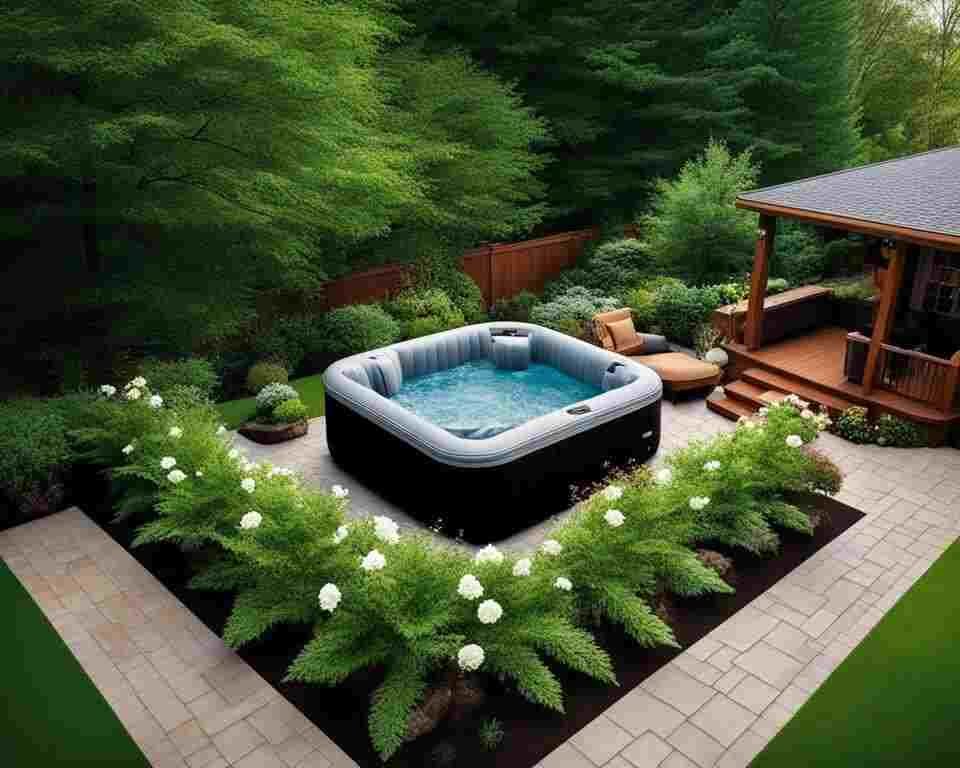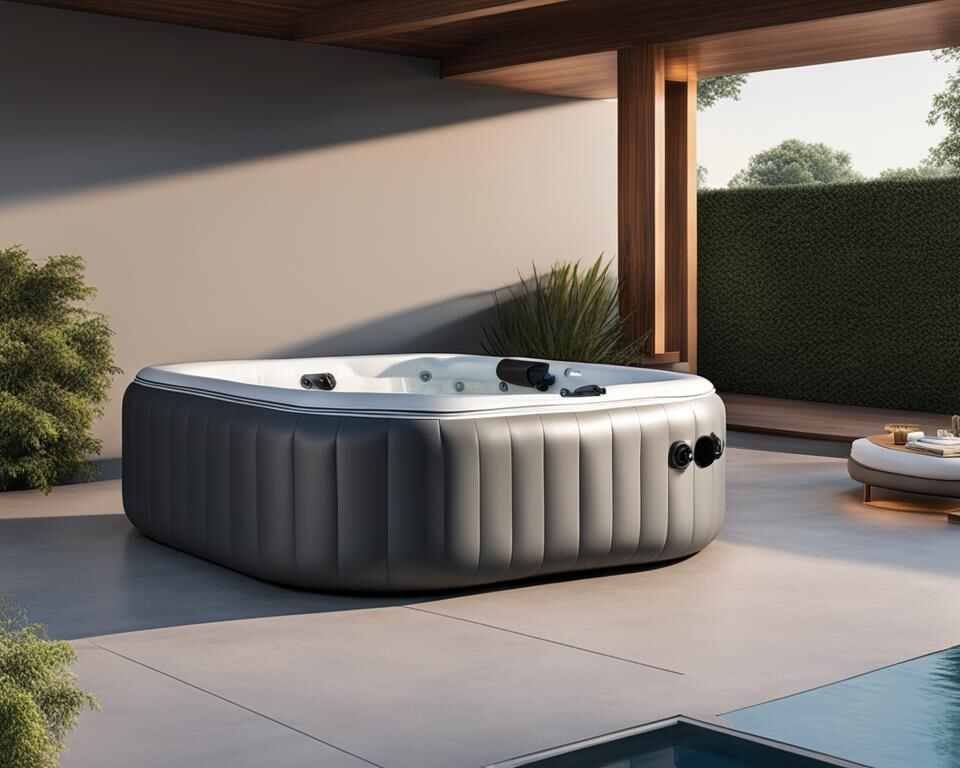Setting up your inflatable hot tub requires careful consideration of the base to ensure optimal durability and comfort. The base provides support for the weight of the hot tub and helps to maintain stability. It also helps to protect the hot tub from damage and provides insulation. Choosing the ideal base for your inflatable hot tub will ensure a safe and enjoyable spa experience.
Key Takeaways:
- Choosing the right base is crucial for setting up your inflatable hot tub.
- The base should provide support, stability, and insulation.
- Consider factors such as weight, durability, and comfort when selecting a base.
- Options for the hot tub base include concrete pads, decking, gravel, pavers, and foam or rubber mats.
- Conduct a site survey to determine the perfect placement for your hot tub.

What Should I Put Under My Inflatable Hot Tub
When setting up an inflatable hot tub, it’s essential to consider what to put underneath it to ensure stability, protection, and a comfortable spa experience. Several options are available, each with its own advantages and considerations. The choice will ultimately depend on factors such as budget, aesthetics, ease of installation, and personal preference.
One popular option is to use concrete pads as a base for the hot tub. Concrete provides a durable and stable surface while also offering insulation. However, it can be relatively expensive and may require professional installation.
Another option to consider is decking. Decking not only adds aesthetic appeal to your hot tub area but can also provide a comfortable and level surface. However, it’s important to ensure that the decking is structurally sound and can support the weight of the hot tub.
Gravel is a more affordable option that is relatively easy to install. It provides good drainage and can help with leveling the hot tub. However, it may not offer the same level of stability as some other base options.
Pavers are another popular choice for a hot tub base. They can add elegance to your outdoor space while also providing stability. However, it’s important to ensure that the pavers are properly installed and leveled to prevent any unevenness.
If you’re looking for a more comfortable and protective option, foam or rubber mats can be used as a ground cover for your hot tub. These mats provide cushioning, insulation, and protect the hot tub from any potential damage.

Ultimately, the choice of what to put under your inflatable hot tub depends on your specific needs and preferences. It’s important to select a base that can support the weight of the hot tub and provide a level and stable surface for your enjoyment. Consider your budget, aesthetics, ease of installation, and the level of protection you desire when making your decision.
Understanding the Importance of a Solid Hot Tub Foundation
The foundation of a hot tub plays a crucial role in its long-term performance and durability. It is essential to understand the weight and support requirements of your hot tub to ensure a solid foundation that can withstand the stresses and strains of regular use.
Recognizing the Weight and Support Requirements
Hot tubs come in various sizes and shapes, and each model has its own weight specifications. Before installing your hot tub, it is vital to determine the weight it will exert on the foundation. This information can usually be found in the manufacturer’s documentation or online resources.
Once you have the weight information, you can assess the structural capacity of your chosen foundation. Different base materials have different load-bearing capacities, so it is important to select one that can adequately support the weight of your hot tub.
Consequences of Poor Foundation Choices
Choosing an inadequate or poorly constructed foundation for your hot tub can have serious consequences. A weak or unstable foundation can lead to structural problems, such as uneven weight distribution and sagging, which may cause damage to the hot tub itself and compromise its functionality.
Poor foundation choices can also result in leaks and plumbing issues, as the weight of the hot tub can place excessive strain on the connections and seals. Over time, this can lead to water damage and costly repairs.
Furthermore, a weak foundation may not provide the necessary insulation, leading to heat loss and increased energy consumption. This can affect the overall efficiency of your hot tub and result in higher operating costs.
Site Survey: The Indispensable Step for Perfect Placement
Before installing your hot tub, it is highly recommended to conduct a site survey to determine the ideal placement and ensure a solid foundation. A site survey involves assessing the ground conditions, slope, accessibility, and other factors that may impact the installation process and overall stability of the hot tub.
During the site survey, consider factors such as drainage, access to utilities, and proximity to structures. It is important to choose a level area that can accommodate the weight of the hot tub and provide adequate space for maintenance and servicing.
By conducting a thorough site survey, you can identify any potential issues and make informed decisions regarding the foundation and placement of your hot tub, ultimately ensuring a solid and lasting installation.
| Hot Tub Model | Weight (lbs) | Recommended Foundation |
|---|---|---|
| Model A | 500 | Concrete pad or decking |
| Model B | 800 | Concrete pad or reinforced gravel base |
| Model C | 1000 | Concrete pad or pavers |
Comparing Hot Tub Base Materials and Surfaces
When it comes to choosing the right base for your hot tub, there are a variety of materials and surfaces to consider. Each option offers unique advantages and considerations that can impact the durability, aesthetics, and overall enjoyment of your hot tub experience. Let’s explore some popular choices:
Concrete: Robust Durability and Insulation

Concrete is a common choice for hot tub bases due to its robust durability and excellent insulation properties. It provides a stable and level surface that can withstand the weight of the hot tub and offers long-term stability. With proper installation, a concrete base can last for many years, making it a reliable option for hot tub owners. Additionally, the thermal properties of concrete help to retain heat, ensuring that your hot tub stays warm for longer periods.
Decking: Aesthetic Appeal with Structural Considerations
Decking can add a touch of elegance to your hot tub setup. It offers a versatile design that can complement various outdoor aesthetics. However, it’s important to consider the structural considerations associated with using decking as a base. The decking material should be able to support the weight of the hot tub and withstand the constant exposure to moisture and fluctuating temperatures. Proper maintenance and regular inspections are essential to ensure the longevity and safety of a deck-based hot tub installation.
Gravel: Affordable and Easy Installation
For those on a budget or seeking a quick and simple installation process, gravel can be a viable option for a hot tub base. Gravel provides good drainage, helps to prevent water pooling, and requires minimal preparation compared to other materials. It’s important to ensure that the gravel is leveled and compacted properly to create a stable surface. Additionally, placing a geotextile fabric under the gravel can help prevent weed growth and improve stability.
Pavers: Elegance Meets Stability
Pavers offer a combination of elegance and stability, making them a popular choice for many hot tub owners. With various colors, patterns, and textures available, pavers can enhance the visual appeal of your hot tub area. They also provide a durable and level surface that can withstand the weight of the hot tub and ensure its stability. Proper installation and joint sanding are crucial for maintaining the integrity and longevity of the paver base.
Understanding the characteristics of each hot tub base material and surface is essential in making an informed decision. Factors such as budget, aesthetics, ease of installation, and maintenance requirements should be considered. By selecting the right base, you can create a sturdy foundation for your hot tub and enhance the overall enjoyment of your spa experience.
Conclusion
Choosing the ideal base for your inflatable hot tub is crucial to ensure a long-lasting and enjoyable spa experience. When making this decision, I recommend considering several factors. First, take into account the weight and support requirements of your hot tub. This will help you select a base that can safely bear the load and provide stability.
Additionally, be aware of the consequences that poor foundation choices can have on your hot tub. A weak or unstable base can lead to structural problems, leaks, and other issues that may compromise the functionality and safety of your hot tub. Always prioritize the durability and performance of your base.
Before settling on a base, I strongly urge you to conduct a site survey. This will give you valuable insights into the perfect placement of your hot tub. By carefully evaluating the terrain and topography of your chosen location, you can ensure a solid foundation for your hot tub.
Lastly, compare the different materials and surfaces available for your hot tub base. Concrete provides robust durability and insulation, making it a popular choice. However, if aesthetics are important to you, consider alternatives like decking or pavers. Gravel is a more affordable option that is easy to install. Take these options into account when choosing the best base for your inflatable hot tub.
In conclusion, by considering the weight and support requirements, understanding the consequences of poor foundation choices, conducting a site survey, and comparing different base materials and surfaces, you can find the best base for your inflatable hot tub. This will ensure optimal durability, comfort, and overall satisfaction with your hot tub setup.

